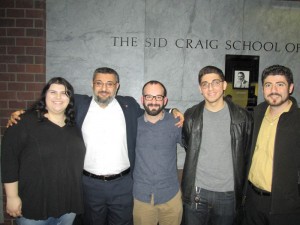
Photo: Barlow Der Mugrdechian
Michael Rettig
Editor
When one typically thinks of the perpetrators of the Armenian Genocide, they usually have in mind high-ranking officials who directed policy, such as Talaat, Enver, or Djemal Pasha. The term “perpetrator” might also conjure up images of gendarmes and soldiers herding Armenian refugees through the desert. However perpetrators were often ordinary people, emphasized Dr. Umit Kurt in his lecture, “A Curious Case of Armenian Genocide Perpetrator Ahmed Faik Bey,” held on Tuesday March 7. This lecture was a part of the Spring Lecture Studies sponsored by the Armenian Studies Program and the Leon S. Peters Foundation.
According to Dr. Kurt, “Perpetrator Studies”—the field of enquiry that seeks to understand the motivations behind perpetrators’ actions—has been largely neglected in the case of the Armenian Genocide. Scholars tend to focus on the motivations of Turkish leaders, rather than trying to understand why ordinary civilians decided to take up arms against their Armenian neighbors. Dr. Kurt’s research fills this gap in the historiography by utilizing archives and memoirs of ordinary people who carried out genocidal policies to examine their lives before and after the Genocide.
Dr. Kurt emphasized that Turkish and Kurdish civilians in local provinces were vital to the Committee of Union and Progress’ (CUP) plot to exterminate the Armenians. In many cases it was the local notables who convinced central authorities to deport the Armenians in their district.
“Political and social elites can either expedite or delay and resist genocidal destruction ordered from above,” explained Dr. Kurt.
Perpetrators were often motivated by different factors; some sought wealth and property while others yearned for a “Turkey for the Turks.” According to Dr. Kurt, self-interest was one of the most sweeping motivations for ordinary people to participate in the massacres. “The Genocide provided numerous profiteers with a unique opportunity to combine the ideologies of the regime with their personal interests. Many of them used the chaotic circumstances to pursue their own self-interests by claiming Armenian property and goods.”
Dr. Kurt examined the careers and motivations of several Turks who participated in the Genocide, such as Ali Cenani Bey and Ahmed Faik Bey. Ali Cenani Bey was elected as president of the CUP in Aintab because the locals wanted a civilian leader. He became one of the main organizers of the deportations in Aintab. Dr. Kurt noted that Cenani Bey was driven more by opportunism than ideology because he protected wealthy Armenian families in order to profit from them. Many other Turkish elites protected select Armenians for personal benefit; most often to use for labor.
Perpetrators such as Ahmed Faik Bey, however, were driven solely by their ideology. He would often file complaints to the central authorities and confronted opportunistic Turks such as Ali Cenani Bey, who protected Armenians.
“Ahmed Bey did not want a single Armenian to remain in Aintab and made a great effort to reveal those who protected them,” said Dr. Kurt.
Ahmed Bey was a loyal CUP party member, who Talaat Pasha trusted to facilitate the Armenian deportations in Aintab. Ahmed Bey was driven by his nationalist ideology and believed that the Armenians were a threat to the Ottoman Empire. According to Dr. Kurt, Ahmed Bey proclaimed that “if one is guilty, all are guilty,” and was largely responsible for escalating the death toll for Armenian deportees in the region.
While Ahmed Bey was driven by ideological motivations, Dr. Kurt noted that many more were driven by self-interest. The potential material gain to be acquired from participation in the massacres inspired a wider amount of people who did not always share similar ideologies to take part in the Genocide. “Entire generations were educated and provided for by the Armenian property and wealth acquired in 1915,” said Dr. Kurt.
Case studies into the lives of these perpetrators are important in understanding the average men who carried out massacres on the local level.
 Hye Sharzhoom Armenian Action
Hye Sharzhoom Armenian Action